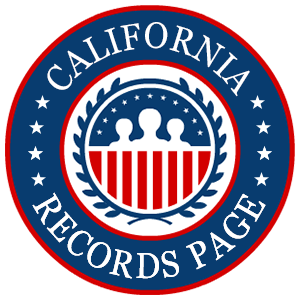California has let its citizens access and check California state records since 1968, but with millions of records on file, figuring out where someone can access which information can prove quite challenging.
This resource compiles all necessary information for the search so that everyone can access the desired public records for free.
Accessing California Public Records
In 1968, then-governor Ronald Reagan signed the California Public Records Act (PRA).1 According to the PRA, all Californians have the right to access records maintained by public or governmental bodies.
California has public record repositories for criminal, court, vital, and inmate records. However, someone looking for information must first determine which government agency handles a particular type of information, which jurisdiction the record falls under, which site hosts it, etc.
Instead of tediously searching the internet, Californians can read below to find the public information and records they’re looking for.
For county-specific details, the following resources review the process to find public records through the respective county and local agencies.
| Resources for Searching California Counties’ Public Records | |
| Alameda County | Sacramento County |
| Los Angeles County | San Bernardino County |
| Orange County | San Diego County |
| Riverside County | Santa Clara County |
Criminal Records in California
Criminal records in the state of California are governed by the Penal Code §§ 11120-11127 and Public Records Act (PRA).
It is the duty of the California Department of Justice (DOJ) to maintain public criminal records or RAP sheets for all criminals in the state.2 A person’s criminal record will contain their:
- Full name
- Date of birth
- Arrests and detentions where a person has not been prosecuted
- Felony and misdemeanor convictions
- Dismissed charges where the person was acquitted
- Drug diversion records (granted when a person convicted of a drug offense completes a diversion program)
- Probation violations3
The DOJ serves as the official record custodian of the state, however criminal records are also stored in the county courthouse and local government agencies.
These records can be helpful for anyone looking to understand someone’s background and criminal history.
Can the Public Access California Criminal Records?
Criminal records in California are available to the public but with some restrictions as mandated by the law.
Members of the public can freely access their own criminal records through the California Department of Justice (DOJ), but–to protect citizens’ privacy–individuals cannot ask for others’ official RAP sheets. Agencies who ask for such records must first register with the California government to gain authorization.
However, if an individual has committed crimes elsewhere in the US, third-party sites can search for crimes nationwide and potentially provide insight into their criminal record while protecting the identity of the requestor.
Only authorized bodies outlined in the California Penal Code Section 11105 can look up someone’s criminal record through the state’s official government repertoires.4 These entities include:
- State agencies that require such information
- State peace officers and city or district attorneys
- Parole and probation officers
- Health officers
- County jail correctional officers
- Humane societies
- County child welfare agency personnel
- Tax agencies
- Other government agencies, as required
How To Look Up California Criminal Records Online
To look up one’s own criminal record, a California resident can visit the Office of the Attorney General or download the Live Scan Fingerprint Form.
On the form, applicants must check “Record Review” under “Type of Application” and enter “Record Review” for “Reason for Application”. Requesters can then take this form to any Live Scan site to obtain their fingerprint.
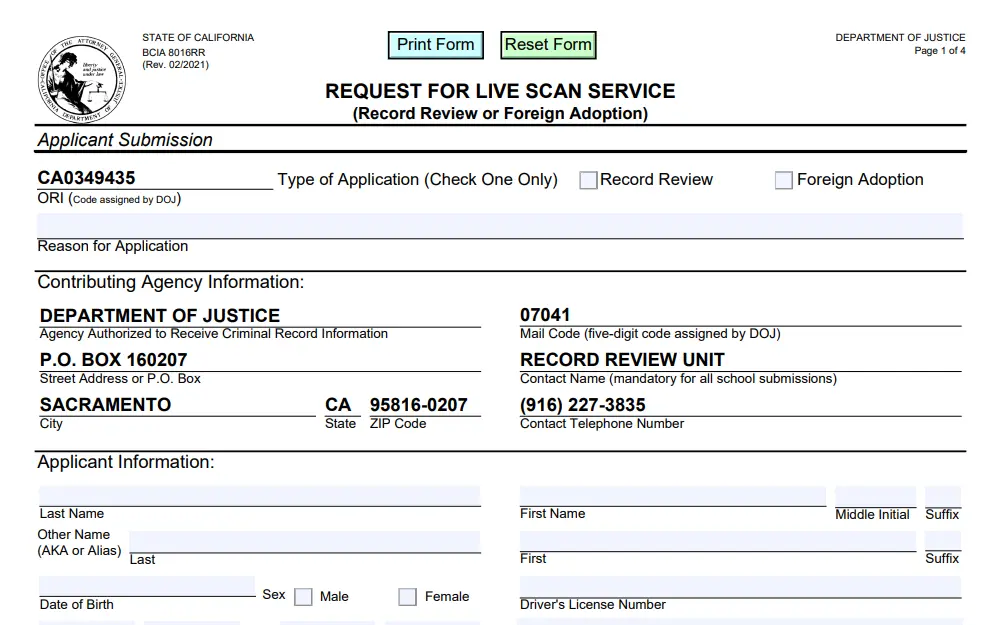
Citizens living outside California will need to contact their local law enforcement agencies to procure a manual fingerprint card and their personal details. They can contact the Record Review Unit at (916)227-3849 in case of difficulties.
After obtaining a Live Scan or manual fingerprint card:
- Fill out an Application to Obtain Copy of State Summary Criminal History Record
- Get a check or money order for the $25 processing fee, payable to the California Department of Justice
- Mail the application, fingerprint card, and a check or money order to the California Department of Justice (DOJ)
Bureau of Criminal Identification and Analysis
Record Review and Challenge Section
PO BOX 160207
Sacramento, CA - Wait for a Record Review response in the mail
Requesters can also apply for a fee waiver if they are on public assistance or have a low or no income and include it in the mail instead of the processing fee.
How To Search Arrest Records in CA
Since California criminal records contain arrest history, the main distinction to be aware of when running a California criminal and arrest records search is that arrest reports describe one specific incident while criminal records are more comprehensive looks at a subject’s entire criminal past.
The subject of a record can request a criminal record by following the steps detailed above, but arrest records can be obtained locally.
Each county’s citizens can procure their arrest reports and mugshots by visiting the local county, courthouse, sheriff’s website to view current inmates, recent arrests or at least find the contact information for the sheriff’s office to inquire by phone or in person.
Checking the county police departments is also an option while looking for arrest records. Contact information can be obtained online or through the county’s website. For example, the Antioch Police Department offers an Adult Arrest Report, listing the adults arrested within their jurisdiction which are updated weekly.
Arrest records where a person has been charged with a crime but acquitted or found not guilty can be expunged or sealed upon request, but the arrestee must contact an attorney to begin this process. If successful, these arrests will no longer appear on the person’s broader criminal record.
Are Juvenile Records Public in California?
Juvenile records are always confidential in California, and the concerned court will automatically seal them after the subject turns 18 based on the California Welfare & Institution Code 827.9. If not, the subject can ask for them to be sealed.
Furthermore, even the parents of the subject cannot access their records without going through court procedures. The California state law only allows agencies like the probation department, schools and courts to access this record. Such agencies are prohibited from giving the said records to the public.
How To Run a Free Warrant Search in California
In California, warrants can be obtained through various means but the best route is through local police departments and/or the county sheriff office.
There are counties providing online tools to access warrant information in California, but if not available it is good to consider visiting the specific department where the warrant occurred or warrant may be issued.
Before visiting in person, you may first contact the department to inquire them of what specific requirement is needed for the search. Sheriff’s contact information and website for California counties are compiled by the California State’s Sheriffs Association.
Most agencies only require valid ID to search and some require a fee.
Individuals may also check the warrants in the Superior Court’s online databases.
Concerned individuals focused on avoiding incarceration and hesitant to visit in person can try submitting a request for public warrant information by mailing the inquiry to the relevant address.
One best example of a county that offers a warrant search tool is San Diego County. The county’s sheriff office provides a warrant query for those curious if they have or someone else a warrant issued for their arrest. Searchers can search by the subject’s name.
There are cases where you only know the first name, no worries, this tool allows citizens to either search by first name, last name or middle name. However for a more precise search, including the individual’s full name will give the best result.
Results will show the list of offenders with their full name, sex, race and DOB. Users can click the link attached to the last name to view more information.
Find Out Who Is on the California Sex Offender Registry
Megan’s Law makes the names and locations of all criminals on the sex offender registry public in accordance with California Penal Code § 290.46.6
The DOJ allows anyone to access the details of sex offenders in California by searching for them by name. This search will show the offenders’ details including:
- Full name and aliases
- Photograph
- Date of birth
- Sex
- Ethnicity
- Height and weight
- Physical markers like hair color, eye color, scars, and tattoos
- Offenses and date convicted
- Current or last known address
- Risk level (1-4)
Alternatively, members of the public can search for offenders nearby by entering their addresses and performing a map search. A map with all markers for all sex offenders in the area will come up. Select any marker to see more info about an offender.
Otherwise, users can also search for offenders in their area by allowing the website to access their location, after which the site will show a similar map of sex offenders nearby.
How To Get a California Background Check
To obtain a background check, an employer must provide the candidate or employee with a BCIA 8016 – Request for Live Scan Service Form. The candidate can then visit a Live Scan fingerprint service location with identification to submit their fingerprints.
If no match is found, the requesting agency will get a response within 48-72 hours of the Live Scan location forwarding the fingerprints to the DOJ. However, if a match is found, a technician must manually review the RAP sheet before responding to the agency and this can take an indefinite amount of time.
How To Obtain California Court Records Online & In Person
Most California state courts keep public electronic court records, which the public can view by visiting the nearest courthouse or browsing the court’s website. These include the Superior Courts of each county and Appellate Courts of each District.
In California, the Superior Courts handle all civil and criminal cases in a county, in addition to small claims cases, appeals of civil cases less than $25,000, misdemeanor appeals, and infraction appeals (such as traffic tickets).7
Meanwhile, Appellate Courts handle appeals of cases from trial (Superior) courts. The California Supreme Court has the most authority, taking on death penalty appeals and disciplinary cases involving judges.
How To Search California Court Records by Name
For Superior Courts of counties and Appellate Courts, The Judicial Branch of California provides a handy list of all courts in the state along with their websites, contact information, and a tool to find a particular court by zip code.8
Once on the court’s website, there will be an option to search for court cases by:
- Name
- Case number
- Calendar (allows access to the court’s calendar along with cases and department)
- Public filings (provides access to non-confidential case information)
Cases tried in the California Supreme Court can be found on the State Courts website itself, where anyone can search for case records using:
- Case number
- Party names
- Attorney names
- Case caption (for example, “Smith v. Jones”)
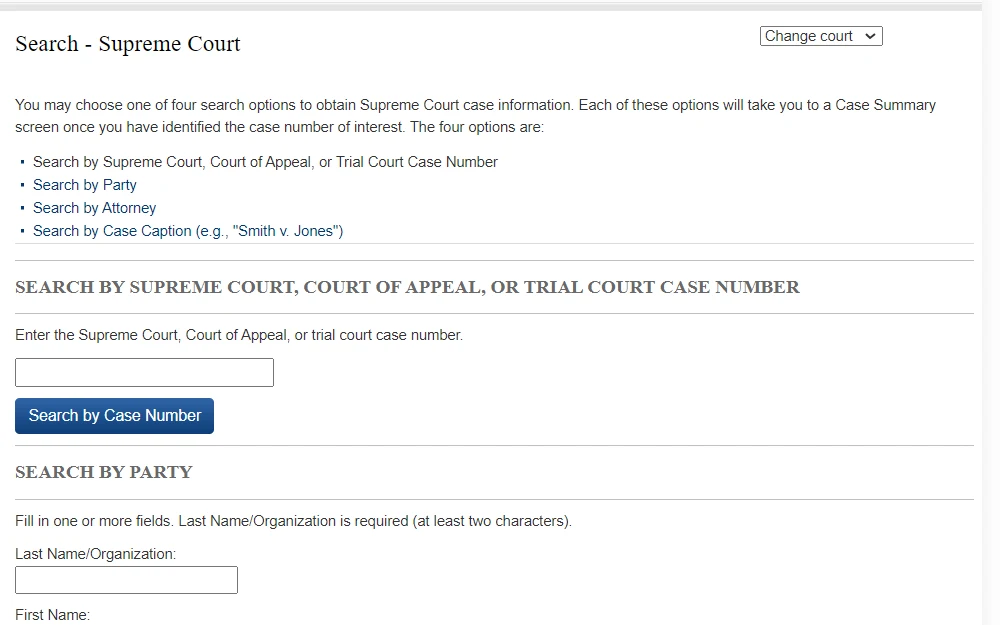
Once a case is found, details about it can be viewed, including:
- Case summary (case number, type, filing date, and location)
- Actions taken so far
- Parties involved
- Attorneys involved
- Rulings (tentative or final)
- Future hearing dates
- Minutes (summary) of the hearing
Searchers can visit the Probate Division of any county court for probate cases.
As an example of how to look up court records by county, searchers in Orange County can use the Case Index Search Tool offered by the county’s Superior Court or visit any of the Orange County Superior Court locations to inquire with the clerk.
Citizens seeking further insight can review more guidance on obtaining court documents and other public records in Orange County.
How To Acquire Bankruptcy Records in California
The United States Bankruptcy Court of the Central District of California and the other 3 bankruptcy courts within the state (Northern, Southern & Eastern) maintain bankruptcy case records for state.
Since these are federal courts (under the central government’s jurisdiction), people can access these case records through the Case Locator on Public Access to Court Electronic Records (PACER).9 However, requesters will have to register first, and each request will cost $0.10 per page, capped at $3 per document.
Alternatively, requesters can call (866)222-8029 toll-free to access the court’s automated Voice Case Information System (VCIS) and provide the case number, name, or social security number. Otherwise, they can visit the courthouse to request bankruptcy records using the Court Locator.
If a bankruptcy case is already closed, people can access such records through the National Archives 10 simple procedure:
- Court where the case was filed
- Case number
- Names of parties
- The time period when the document was filed
- FRC transfer number (1940 and beyond) which can be obtained by contacting the court
While it does not cost anything to search, reproductions of case files might incur a fee which the Archives will communicate to the requester afterward. Send this information to the National Archives Bankruptcy Case Files location.
National Archives
400 West Pershing Road
Kansas City Missouri 64108
Phone: 816-268-8000
Email: [email protected]
Find California State Property Records
California public records include property and land ownership information.
Members of the public can visit any county’s website to search for property records within that county, typically through an online index search. This search will usually provide:
- Property ownership information
- Assessed value
- Property description
- Tax information
- Sales history
- Maps or location
- Online property index
If the county does not provide online records, interested parties can visit or call the County Clerk’s or the Registrar’s Office through the contact details provided on the website:
Look Up California Corporation & Business Records
The California Secretary of State provides public access to information about corporations and businesses online.11
Citizens can perform a Business Search with the business’ name or file number, including inactive companies, through an Advanced Search.
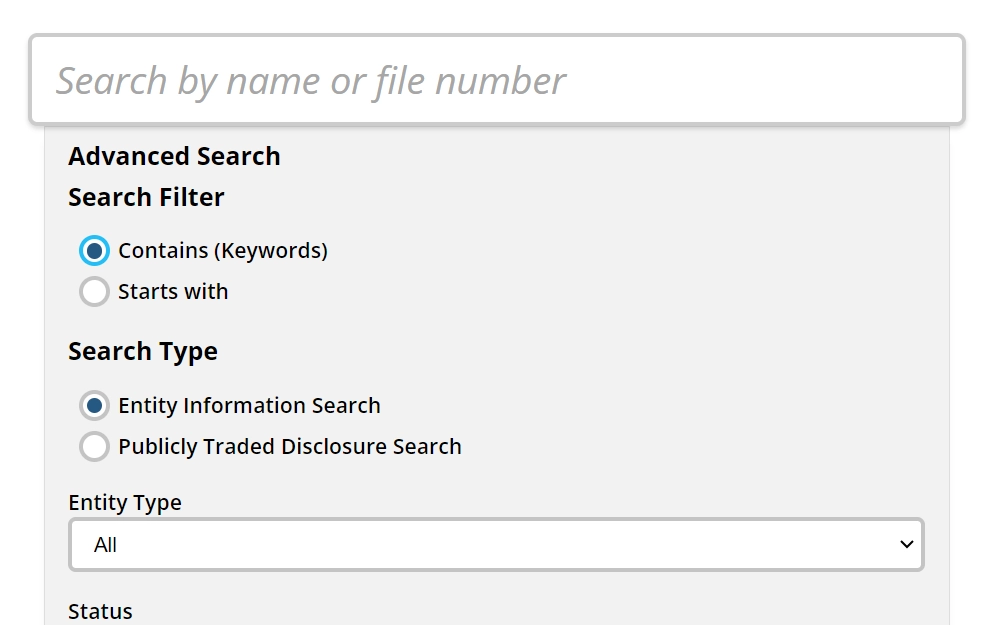
This search will show the following information for a business:
- Initial filing date
- Status (active, terminated, etc.)
- SOS, FTB, Agent, and VCFCF status
- State where the business was formed
- Principal and mailing address
- Information due date
- Business agent information (usually the person who owns the business)
Find CA State Tax Records
California’s property tax records are public and can be viewed at the applicable county Assessor’s or Treasurer’s office. These tax records come in two categories:
- Secured: Tax on fixed or “real” property, including houses and land
- Unsecured: Value-based (ad valorem) tax on movable property
On the county Assessor’s or Treasurer’s page, any member of the public can search property tax records by:
Secured:
- Parcel number (assigned by a local tax assessment office to help identify properties)
- Street address
- Tax default number (TDN)
Unsecured:
- Tax collector reference number
- Tax year and assessment number
- Business name
- Tax lien number
- Watercraft registration number
- Aircraft registration number
This search will display the property’s tax history, which can be especially useful for the property owner to keep track of, including:
- Parcel number
- Property location
- Tax rate area
- Roll type (secured or unsecured)
- Status of each tax payment (paid or unpaid)
- Assessed tax value
- Tax exemptions
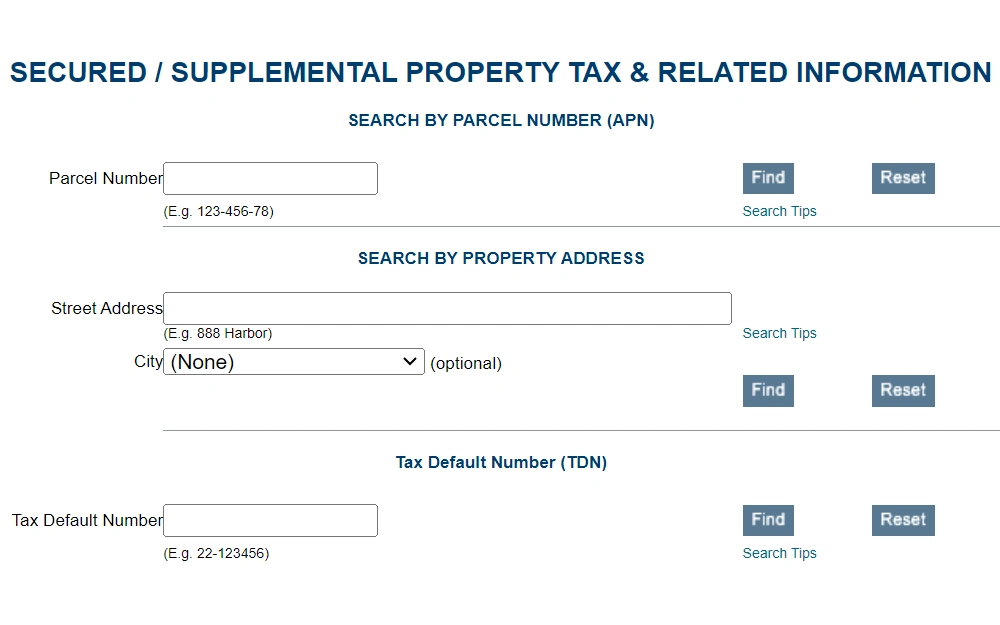
Vital Records of California
Vital records generally contain birth and death certificates, marriage records, and divorce records, among other documents. In California, people can also obtain fetal death or stillbirth records. The state disburses them to members of the public as requested, and they can help find out if someone is married, divorced, etc.
Are Vital Records Public Information in CA?
For searchers wondering if marriage records are public information, all vital records are public in California. However, only authorized individuals can obtain authorized copies of a document.12
These individuals include:
- The person named on the record
- The parent, legal guardian, spouse, domestic partner, sibling, grandparent, or grandchild of the subject
- Someone entitled to the record because of a court order
- An attorney or adoption agency
- A representative of a government agency
- A court-appointed person or agency on behalf of a person or their estate
- A funeral establishment agent
If the requester is not entitled to an authorized copy, they can still get an informational copy of the record. For example, a state of California divorce record will have “Informational, Not a Valid Document to Establish Identity” printed across it.
The following image shows the divorced population in each California county per the Census Bureau:
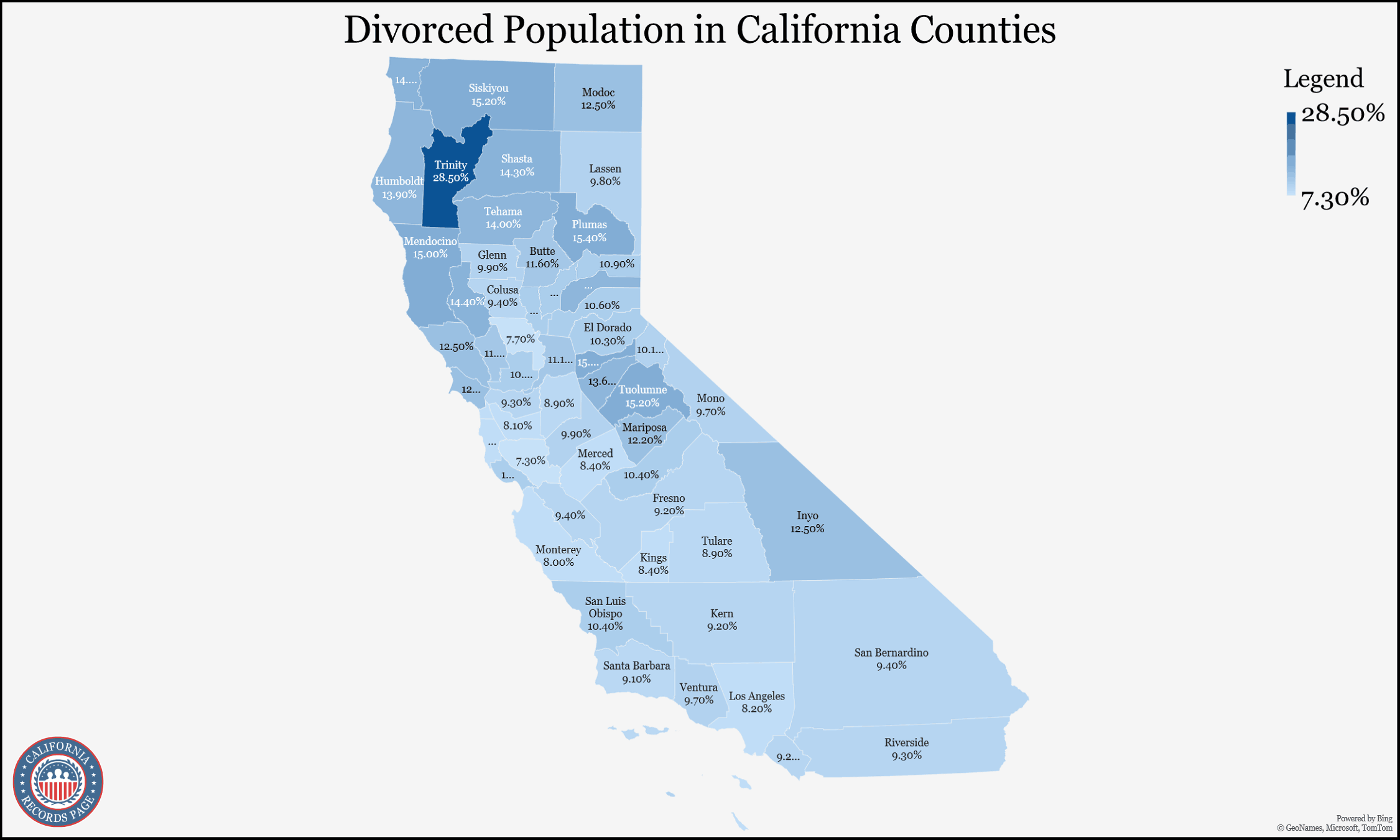
How To Access California Vital Records & Statistics for Free
The California Department of Public Health – Vital Records (CDPH-VR) is responsible for providing the public with copies of vital records.13
Online: To obtain copies of vital records online, requesters will have to use a third-party website like VitalChek or State Vital Records. Prices can range greatly depending on the custodian, record, optional expedited shipping and whether or not the record is certified/notarized.
By Mail: To obtain a copy by mail, applicants must:
- Fill up the correct form
- Obtain a notarized sworn statement to establish their identity (not applicable for informational copies)
- Get a check or money order for the processing fee
- Mail it to the CDPH-VR at:
California Department of Public Health (CDPH)
Vital Records – MS 5103
PO Box 997410
Sacramento, CA 95899-7410
Each copy can take 5-7 weeks for processing, and fees vary according to the record you want to obtain.
- Birth certificate – Form VS 111, $29
- Death certificate – Form VS 112, $24
- Marriage certificate (only for public marriages) – Form VS 113-A, $17
- Divorce certificate (public divorce records are not available online) – Form VS 113-B, $16
- Fetal death certificate – Form VS 12, $18
- Stillbirth certificate (only available to parents) – Form VS 13-E, $18
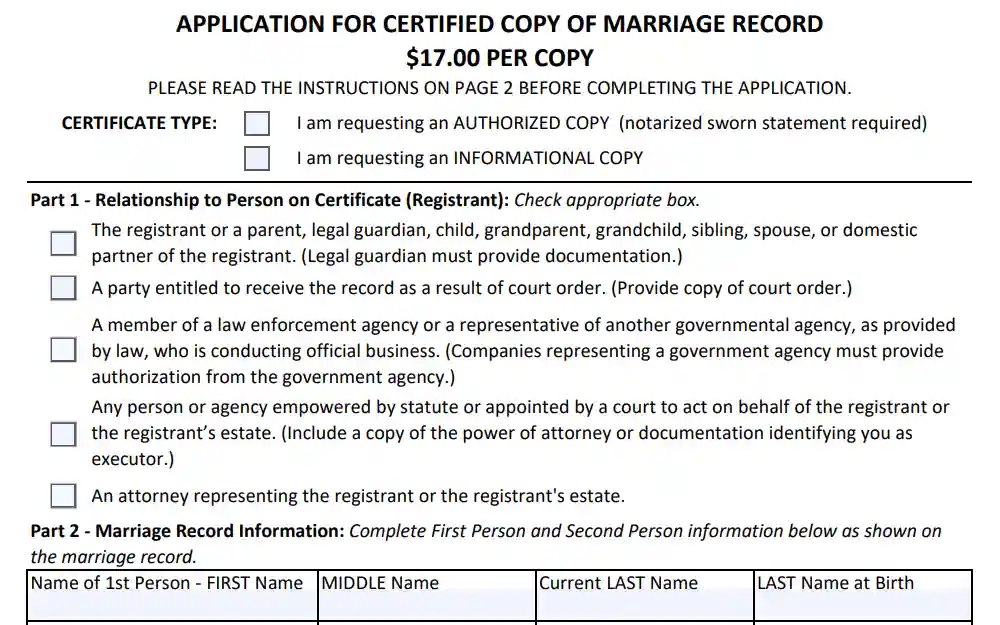
State agencies can also request records via the California State Records Center, but this option is not available to the general public.
County Clerk or Recorder: People can obtain birth and death records for the current year and the year prior by calling or mailing the county recorder’s office, or the county clerk’s office for confidential marriage records.
Record seekers can review the steps for seamlessly obtaining California marriage records or check out the process of accessing divorce records in CA for a more efficient and effective search.
California State Inmate Records
In any given month, California handles over 90,000 inmates so it can be difficult for a loved one to find an inmate between the county, state, and federal correctional facilities.14 Generally, an inmate record will contain:
- Name
- CDCR or jail number
- Age
- Date of incarceration
- Location
- Directions to the location
- Parole eligibility date
There are several options you can search for inmates in the state. List of resources and details on how to search will be explained below.
How To Find Inmates in California (Jails)
Anyone can visit the county’s website and use the inmate locator tool for county jail records. They can find inmates by entering their name, personal file number (PFN), or viewing all inmates booked in the past 24 hours to see recent arrests:
If an inmate cannot be found using the county links provided above, the searcher may have better luck seeking a specific individual using city jail links below:
How To Search for Prisoners in California
The California Department of Corrections & Rehabilitation (CDCR) maintains an up-to-date record of all inmates and their current locations.15
Anyone can find out if someone was arrested or is in jail using the CDCR’s Inmate Locator by entering either CDCR number or last name. Searchers can also enter first and middle names for more accurate results.
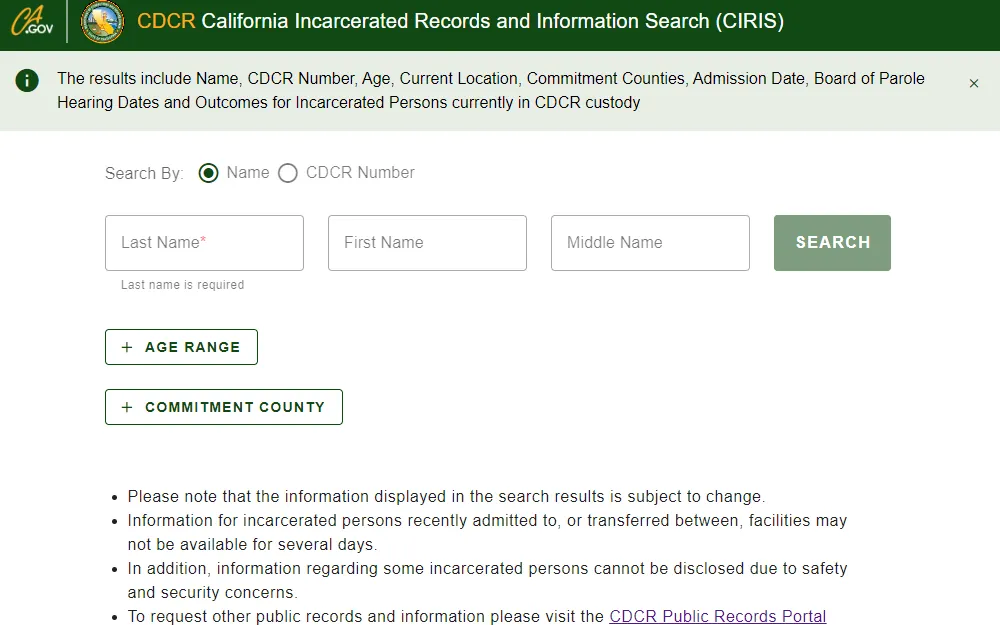
Search for Inmate Release Dates Online
When performing a search via a county inmate locator or the CDCR’s inmate lookup tool, searchers will find either a parole eligibility date (for prisoners) or an expected probation or release date (for those in jail).
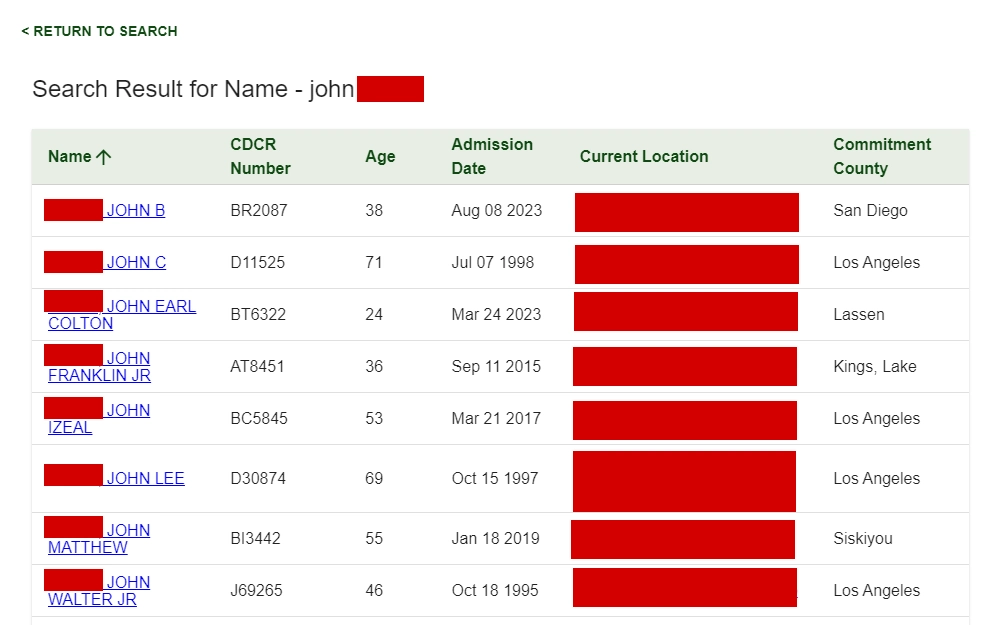
A parole date is the earliest date an inmate can be released; reviewing details of the California parolee lookup process can give further insight into this matter as well.
Visit & Send Money to Individuals Incarcerated in California Prisons
Loved ones can send money to a California prisoner with an Electronic Funds Transfer (EFT), lockbox, or check or money order.
- EFT – Use GTL, JPay, or Access Corrections to send money.
- Lockbox – Fill out the Money Order Deposit Form (coupon), make it payable to JPay, and mail it to:
JPay
2022 South Figueroa Street
Box Number 3001
Los Angeles, CA 90007
- Check or Money Order – Locate the inmate and mail the check or money order to the facility.
To visit an inmate, family and friends don’t need to figure out how to get jail paperwork. They can use the visiting Scheduling Application (VSA) provided by the California Department of Corrections and Rehabilitations (CDCR). Users must register and schedule a visit through this service. They can also opt to schedule a video visit which they can join via WebEx.
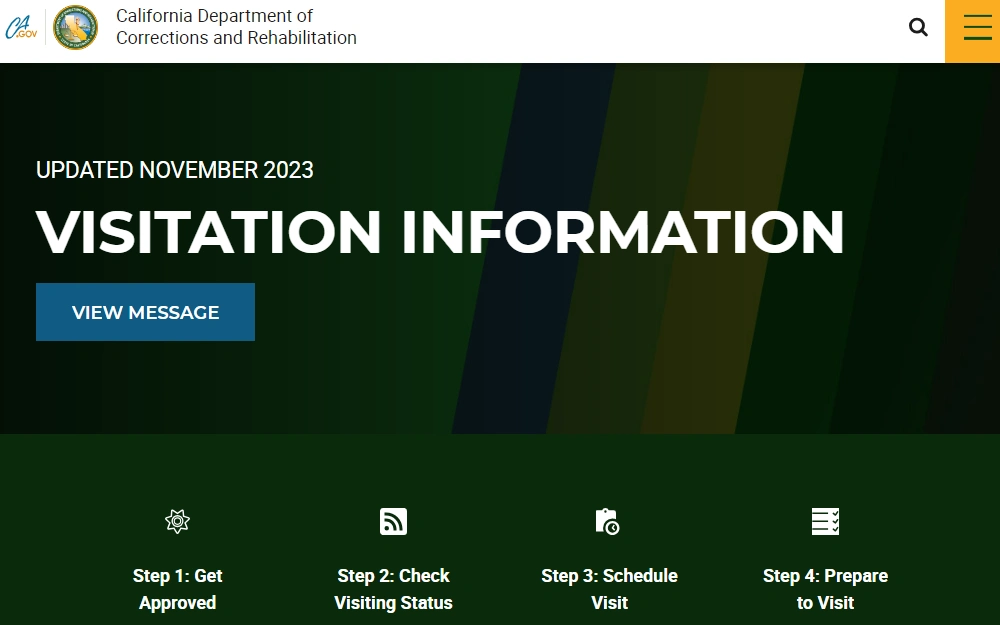
If hopping from site to site to track down information seems too complicated, searchers can refer to this free guide for the most reliable, affordable and efficient methods of obtaining each type of California state records.
Individuals can easily conduct background checks or retrieve a copy of their own criminal records from the California DOJ, utilize the CDCR inmate locator to find current prisoners, and access other records from local law enforcement, clerks of court, or vital records offices.
References
1California Department of Community Services and Department. (n.d.). Public Records Act. Retrieved April 25, 2024 from <https://www.csd.ca.gov/Pages/Public-Records-Act.aspx>
2(n.d.). State of California – Department of Justice – Office of the Attorney General. Retrieved May 28, 2022, from <https://oag.ca.gov/about>
3How to Read a California Department of Justice Criminal History Report (RAP Sheet).pdf. (2017, December 9). Criminal Justice and Employment Initiative. Retrieved May 28, 2022, from <https://cjei.cornell.edu/sites/default/files/inline-files/How%20to%20Read%20a%20California%20Department%20of%20Justice%20Criminal%20History%20Report%20%28RAP%20Sheet%29.pdf>
4Section 11105. :: 2016 California Code :: US Codes and Statutes :: US Law :: Justia. (n.d.). Justia Law. Retrieved May 28, 2022, from <https://law.justia.com/codes/california/2016/code-hsc/division-10/chapter-3/article-1/section-11105>
5California Juvenile Records Now Automatically Sealed As Probation Ends. (2018, January 25). Shouse Law Group. Retrieved May 28, 2022, from <https://www.shouselaw.com/ca/blog/criminal-defense/california-juvenile-records-automatically-sealed-upon-completion-of-probation/>
6(n.d.). California Megans Law. Retrieved May 28, 2022, from <https://www.meganslaw.ca.gov/>
7How Courts Work – getting_started_selfhelp. (n.d.). California Courts. Retrieved May 28, 2022, from <https://www.courts.ca.gov/998.htm?rdeLocaleAttr=en>
8(n.d.). California Courts – Home. Retrieved May 28, 2022, from <https://www.courts.ca.gov/home.htm>
9(n.d.). Public Access to Court Electronic Records | PACER: Federal Court Records. Retrieved May 28, 2022, from <https://pacer.uscourts.gov/register-account>
10(n.d.). National Archives |. Retrieved May 28, 2022, from <https://www.archives.gov/research>
11(n.d.). California Secretary of State: Contact. Retrieved May 28, 2022, from <https://www.sos.ca.gov/administration/contact-information>
12Authorized Copy vs. Informational Copy. (2020, May 8). CDPH. Retrieved May 28, 2022, from <https://www.cdph.ca.gov/Programs/CHSI/Pages/Authorized-Copy-vs--Informational-Copy.aspx>
13(n.d.). CDPH Home. Retrieved May 28, 2022, from <https://www.cdph.ca.gov/>
14Report #: SOMS-TPOP-1, Page 1 California Department of Corrections and Rehabilitation Division of Correctional Policy Research a. (2022, April 1). CDCR. Retrieved May 28, 2022, from <https://www.cdcr.ca.gov/research/wp-content/uploads/sites/174/2022/04/Tpop1d2203.pdf>
15(n.d.). CDCR: The California Department of Corrections and Rehabilitation. Retrieved May 28, 2022, from <https://www.cdcr.ca.gov/>
16BCIA 8016RR – REQUEST FOR LIVE SCAN.” California Department of Justice. Accessed 4 May 2023. <https://oag.ca.gov/sites/all/files/agweb/pdfs/fingerprints/forms/bcia_8016RR.pdf>
17Home | Supreme Court of California. Accessed 4 May 2023. <https://www.courts.ca.gov/supremecourt.htm>
18Search | California Secretary of State.” bizfile Online. Accessed 4 May 2023. <https://www.sos.ca.gov/business-programs/business-entities/cbs-search-tips>
19County of Orange – Treasurer-Tax Collector. Accessed 4 May 2023. <https://tax.ocgov.com/tcweb/search_page.asp>
20CDPH. Accessed 4 May 2023. <https://www.cdph.ca.gov/CDPH%20Document%20Library/ControlledForms/VS113a.pdf>
21CDCR Public Inmate Locator Disclaimer. Accessed 4 May 2023. <https://inmatelocator.cdcr.ca.gov/search.aspx>
22CDCR Visitation Updates and Information.” CDCR. Accessed 4 May 2023. <https://www.cdcr.ca.gov/visitors/>
